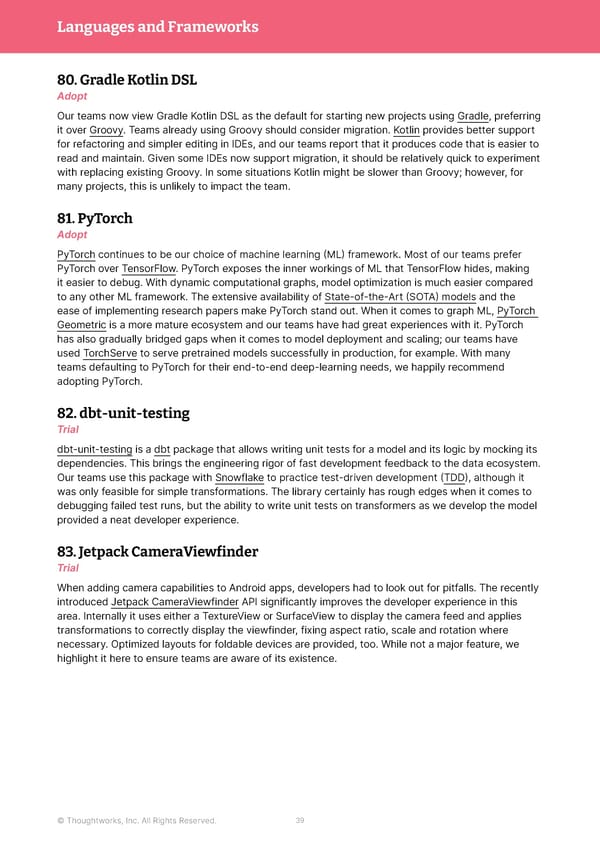Languages and Frameworks 80. Gradle Kotlin DSL Adopt Our teams now view Gradle Kotlin DSL as the default for starting new projects using Gradle, preferring it over Groovy. Teams already using Groovy should consider migration. Kotlin provides better support for refactoring and simpler editing in IDEs, and our teams report that it produces code that is easier to read and maintain. Given some IDEs now support migration, it should be relatively quick to experiment with replacing existing Groovy. In some situations Kotlin might be slower than Groovy; however, for many projects, this is unlikely to impact the team. 81. PyTorch Adopt PyTorch continues to be our choice of machine learning (ML) framework. Most of our teams prefer PyTorch over TensorFlow. PyTorch exposes the inner workings of ML that TensorFlow hides, making it easier to debug. With dynamic computational graphs, model optimization is much easier compared to any other ML framework. The extensive availability of State-of-the-Art (SOTA) models and the ease of implementing research papers make PyTorch stand out. When it comes to graph ML, PyTorch Geometric is a more mature ecosystem and our teams have had great experiences with it. PyTorch has also gradually bridged gaps when it comes to model deployment and scaling; our teams have used TorchServe to serve pretrained models successfully in production, for example. With many teams defaulting to PyTorch for their end-to-end deep-learning needs, we happily recommend adopting PyTorch. 82. dbt-unit-testing Trial dbt-unit-testing is a dbt package that allows writing unit tests for a model and its logic by mocking its dependencies. This brings the engineering rigor of fast development feedback to the data ecosystem. Our teams use this package with Snowflake to practice test-driven development (TDD), although it was only feasible for simple transformations. The library certainly has rough edges when it comes to debugging failed test runs, but the ability to write unit tests on transformers as we develop the model provided a neat developer experience. 83. Jetpack CameraViewfinder Trial When adding camera capabilities to Android apps, developers had to look out for pitfalls. The recently introduced Jetpack CameraViewfinder API significantly improves the developer experience in this area. Internally it uses either a TextureView or SurfaceView to display the camera feed and applies transformations to correctly display the viewfinder, fixing aspect ratio, scale and rotation where necessary. Optimized layouts for foldable devices are provided, too. While not a major feature, we highlight it here to ensure teams are aware of its existence. © Thoughtworks, Inc. All Rights Reserved. 39
 Immersive Experience — Vol 28 | Thoughtworks Technology Radar Page 38 Page 40
Immersive Experience — Vol 28 | Thoughtworks Technology Radar Page 38 Page 40